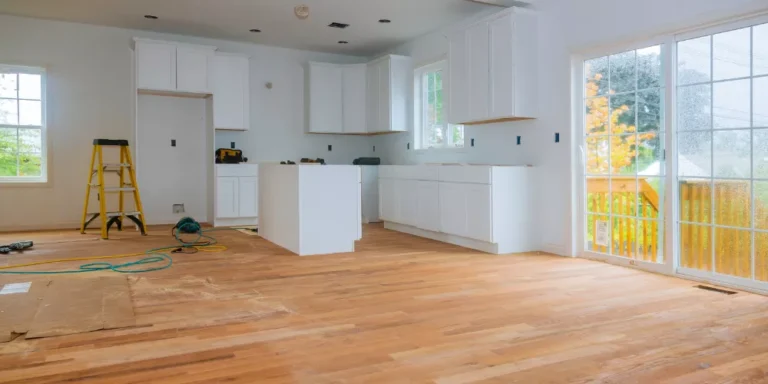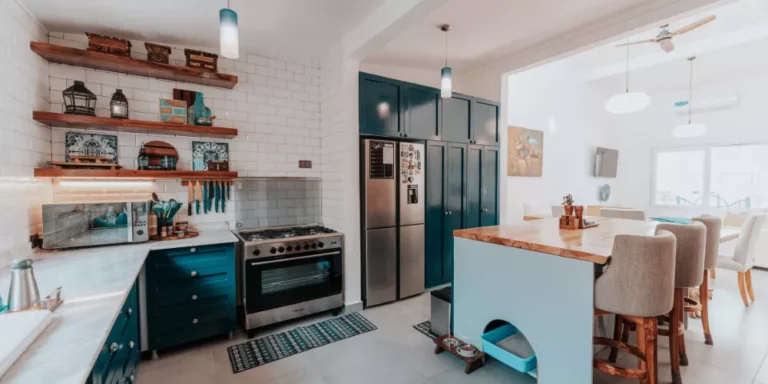How can I add storage solutions in a small kitchen
Maximizing storage in a small kitchen is a challenge faced by many homeowners across the USA. Small kitchens often struggle with limited counter space, cabinets, and pantry areas. Efficient storage solutions make cooking and meal preparation more organized and enjoyable. A clutter-free kitchen improves both functionality and aesthetics. Modern kitchen designs prioritize smart storage to make the most of every inch. Using vertical space, hidden compartments, and modular designs can transform a cramped kitchen into a highly functional space. Proper planning ensures that storage solutions blend seamlessly with the kitchen’s style. Multi-purpose furniture and appliances help reduce clutter. Innovative storage keeps essential items within reach while maintaining a tidy look. Drawer organizers, pull-out shelves, and lazy Susans increase accessibility. Overhead shelving and wall-mounted racks free up counter space. Magnetic strips or hooks can hold utensils and knives safely. Small kitchen islands or carts add both storage and workspace. Efficient pantry organization makes it easier to store food items systematically. Cabinet doors can house additional storage racks. Storage solutions should balance practicality with aesthetics. Utilizing corners and under-sink spaces improves space efficiency. Lighting plays a role in making storage areas visible and accessible. Regular decluttering and organization maintain functionality. Choosing quality materials ensures longevity and durability. Small kitchen storage solutions enhance usability, comfort, and overall home value.
How can I add storage solutions in a small kitchen
Adding storage solutions in a small kitchen requires creativity and strategic planning. Homeowners can maximize space while keeping the kitchen organized and functional.
1. Installing Pull-Out Shelves
Pull-out shelves make deep cabinets more accessible. Items in the back of cabinets are easier to reach. This prevents clutter from accumulating in hard-to-reach areas. Pull-out shelves are ideal for pots, pans, and pantry items. Adjustable shelves allow customization based on storage needs. Slide-out baskets can organize canned goods or spices. Heavy-duty rails support larger or heavier items. Pull-out trays reduce the need to bend or stretch. Proper spacing ensures smooth operation. Installing handles or grips improves usability. These shelves are suitable for both base and upper cabinets. Use them for organizing cleaning supplies under the sink. Pull-out pantry units maximize narrow spaces. Easy installation kits are available for DIY projects. Proper measurement ensures a perfect fit. Consider materials like metal or wood for durability. Smooth glides prevent items from tipping. Pull-out shelves increase kitchen efficiency and reduce frustration. They make small kitchens feel larger by enhancing accessibility. Pull-out systems can complement lazy Susans for optimal use of corner cabinets.
2. Using Corner Lazy Susans
Corner cabinets often waste space without proper solutions. Lazy Susans rotate to provide access to every corner of the cabinet. They are perfect for storing spices, condiments, or small kitchen tools. Adjustable-height shelves accommodate taller items. Turntables prevent items from being forgotten in the back. They are available in both circular and kidney-shaped designs. Lazy Susans can be installed in base or wall cabinets. Combining with pull-out shelves further enhances usability. High-quality bearings ensure smooth rotation. Anti-slip mats keep items in place. Properly sized units maximize corner storage capacity. Use tiered designs to organize multiple items efficiently. Cleaning and maintenance are simple with removable trays. Lazy Susans reduce clutter and make kitchens more functional. They allow homeowners to utilize awkward spaces effectively. Installing a lazy Susan is often cost-effective and easy. They prevent stacked items from falling over. Homeowners can customize materials to match cabinetry. Corner solutions improve kitchen flow and organization. Lazy Susans are particularly helpful in small kitchens where every inch counts. They transform neglected corners into practical storage.
3. Adding Wall-Mounted Shelves
Wall-mounted shelves create vertical storage without taking up counter space. They are ideal for frequently used items like spices, utensils, or cookbooks. Open shelves provide easy access and visibility. Floating shelves add a modern touch to the kitchen design. Shelves can be installed above countertops, appliances, or sinks. Adjustable brackets allow for height customization. Use baskets or containers to keep small items organized. Wall-mounted racks can also hold mugs or cookware. Ensure shelves are anchored properly to support weight. Combining shelves with hooks or magnetic strips increases versatility. Decorative elements can be incorporated to maintain style. Shelving units free up cabinet space for larger items. Proper spacing prevents overcrowding and improves usability. Homeowners can use corner walls to maximize storage. Wall-mounted shelving is an affordable storage solution. Shelves can double as display areas for decorative kitchenware. Consider moisture-resistant materials near sinks. Regular maintenance keeps shelves tidy and dust-free. Open shelving encourages organization since items are visible. Wall-mounted storage makes kitchens feel more open and airy. It provides functional space without remodeling.
4. Installing Overhead Pot Racks
Overhead pot racks free up cabinet space for other items. Hanging pots and pans from a ceiling-mounted rack keeps them within reach. This also adds a decorative, professional look to the kitchen. Choose sturdy racks that can support heavy cookware. Install over islands or workspaces for convenience. Adjustable hooks allow for versatile arrangement. Use racks with built-in shelves for smaller utensils. Ensure racks are mounted to secure ceiling beams for safety. Regular cleaning prevents grease and dust buildup. Overhead racks help declutter cabinets and drawers. They are ideal for small kitchens with limited storage. Racks with additional hooks can hold kitchen tools or oven mitts. Magnetic or rod systems enhance functionality. Consider the height to prevent interference with movement. Overhead storage maximizes vertical space efficiently. It also showcases cookware attractively. Rack materials like stainless steel or wrought iron offer durability. Hanging storage reduces countertop clutter. Overhead racks improve workflow by keeping essential items accessible. They complement other storage solutions like wall shelves. Proper planning ensures safety and aesthetic integration.
5. Using Drawer Organizers
Drawer organizers separate utensils, cutlery, and kitchen tools for easy access. They prevent clutter and increase efficiency. Adjustable or modular organizers fit different drawer sizes. Include compartments for knives, spoons, and specialty tools. Use deep drawers for storing pots, pans, or Tupperware. Non-slip liners keep items in place. Vertical dividers organize baking sheets or cutting boards. Customizable inserts allow for changes in storage needs. Organizers reduce time spent searching for items. They maintain a neat appearance in small kitchens. Drawer organizers work for junk drawers or utensil drawers. Consider materials like bamboo or plastic for durability. Efficient organization prevents overcrowding. Deep drawers can incorporate pull-out trays for additional storage. Dividers help keep frequently used items accessible. Organizers improve kitchen workflow and preparation speed. Combine with labels for better categorization. Proper sizing ensures smooth drawer operation. Drawer storage can be optimized for maximum space utilization. Easy cleaning and maintenance enhance convenience. Drawer organizers make small kitchens highly functional and tidy.
6. Adding Pull-Out Pantry Units
Pull-out pantry units make use of narrow spaces between cabinets or walls. They provide vertical storage for canned goods, spices, or dry items. Adjustable shelves allow flexibility in storing items of various sizes. Units slide out completely for easy access. They prevent wasted space in small kitchens. Tall, slim designs fit into tight spaces efficiently. Pull-out pantries can be integrated with existing cabinetry. Smooth rails ensure effortless operation. High-quality materials prevent sagging or wear. Some units include built-in spice racks or containers. They reduce countertop clutter and organize essentials. Proper measurement ensures the unit fits perfectly. Units are available in DIY kits or professional installations. Labels or transparent containers improve organization. Pull-out pantry units increase storage without enlarging the kitchen footprint. They make inventory management easier for meal prep. Cleaning is easy with removable trays or baskets. Efficient design optimizes narrow spaces for maximum benefit. These units are particularly helpful in small, compact kitchens. Pull-out pantries enhance usability, accessibility, and overall kitchen organization.
7. Installing Magnetic Strips and Hooks
Magnetic strips keep knives and metallic utensils visible and accessible. Hooks can hold pots, pans, mugs, or towels. These solutions free up drawers and cabinets. Install strips above countertops or near prep areas for convenience. Ensure proper mounting for weight support. Hooks can be mounted on walls, inside cabinet doors, or on the ceiling. Use decorative hooks to maintain kitchen style. Magnetic strips prevent drawer clutter and improve workflow. Hooks provide versatile storage for various kitchen items. Regular maintenance ensures items remain organized. Safety precautions prevent accidental cuts from knives on magnetic strips. Both solutions maximize vertical space efficiently. They are cost-effective storage options. Hooks and strips allow flexible arrangement based on changing needs. Combining with shelves or racks enhances functionality. Metal strips can be extended for additional items. Hooks can store frequently used utensils near cooking areas. These tools improve accessibility in small kitchens. Magnetic and hook storage complements other space-saving solutions. Proper planning ensures optimal use without overcrowding. They increase efficiency while maintaining a neat kitchen appearance.
8. Using Stackable Storage Containers
Stackable containers organize pantry items, reducing clutter and maximizing space. Use clear containers for visibility of contents. Uniform sizes allow for neat stacking. Airtight containers preserve food freshness and prevent pests. Stackable bins can store grains, snacks, or baking ingredients. Labels improve organization and reduce search time. Containers fit in cabinets, drawers, or on shelves. Modular systems allow adjustments based on inventory. Stackable storage utilizes vertical space effectively. Consider materials like BPA-free plastic or glass for durability. Containers prevent spills and make meal preparation easier. Small kitchens benefit from uniform containers for compact storage. Stackable solutions can also organize kitchen tools or cleaning supplies. Rotation of stock is easier with transparent containers. They maintain a clean, clutter-free environment. Containers save time during cooking and meal prep. Proper sizing ensures stable stacking. Stackable storage reduces the need for frequent cabinet rearrangement. They complement pull-out pantries and shelves. Using stackable containers maximizes capacity while keeping a tidy appearance.
9. Incorporating Small Kitchen Islands or Carts
Small islands or rolling carts provide additional storage and counter space. They can hold appliances, utensils, or pantry items. Carts with shelves, drawers, or cabinets increase functionality. Rolling units offer mobility and flexibility. They can double as prep stations or serving areas. Overhead racks or hooks on islands provide extra storage. Consider compact designs for small kitchens. Multi-purpose islands save space while improving workflow. Some carts include cutting boards, spice racks, or wine holders. Proper placement ensures smooth traffic flow. Materials like wood or metal provide durability and style. Islands can be customized to match existing cabinetry. Storage under the island can include pull-out bins or shelves. Regular maintenance preserves appearance and functionality. Rolling carts can be moved for cleaning or access to appliances. Islands enhance the overall usability of small kitchens. They provide temporary workspaces without permanent remodeling. Compact islands balance storage, aesthetics, and convenience. Island storage solutions are highly versatile for small kitchen layouts.
10. Utilizing Cabinet Door Storage
Cabinet doors provide hidden storage opportunities. Add racks, hooks, or small shelves inside doors. Perfect for spices, cutting boards, or cleaning supplies. Magnetic strips on the inside of doors can hold knives or metallic tools. Door-mounted organizers keep frequently used items within reach. This maximizes unused space efficiently. Adjustable racks fit various door sizes. Use shallow compartments for lids or small items. Plastic or metal organizers are easy to install. Doors with integrated storage reduce clutter in cabinets. Hinged spice racks can hold jars without taking shelf space. Proper installation ensures stability and accessibility. Door storage complements drawer and shelf organization. Items stored on doors are immediately visible and accessible. This solution is particularly helpful for narrow cabinets. Labels and clear containers enhance efficiency. Regular maintenance ensures items remain in place. Using cabinet doors for storage creates more usable space. It keeps countertops clear for prep work. Cabinet door storage is an affordable, high-impact solution for small kitchens.
Conclusion
Adding storage solutions in a small kitchen requires creativity and strategic planning. Pull-out shelves and pantry units make cabinets more accessible and organized. Lazy Susans, wall-mounted shelves, and overhead pot racks maximize vertical and corner spaces. Drawer organizers, magnetic strips, hooks, and stackable containers improve accessibility and reduce clutter. Small islands or carts provide both storage and additional workspace. Cabinet door storage utilizes hidden areas efficiently. Combining multiple storage solutions ensures a functional, organized, and visually appealing kitchen. Space-saving solutions improve workflow and meal preparation. Maximizing vertical space and underused areas increases overall capacity. Proper measurement and planning prevent overcrowding and improve usability. Using durable, quality materials ensures longevity. Regular maintenance and decluttering preserve functionality. Strategic storage planning balances aesthetics, convenience, and efficiency. Small kitchens can feel larger and more comfortable with smart solutions. Energy efficiency can also improve with better organization. Storage solutions increase property appeal and resale value. Homeowners gain both practical benefits and aesthetic enhancement. Thoughtful storage solutions create a kitchen that is highly functional, organized, and enjoyable for everyday use.







